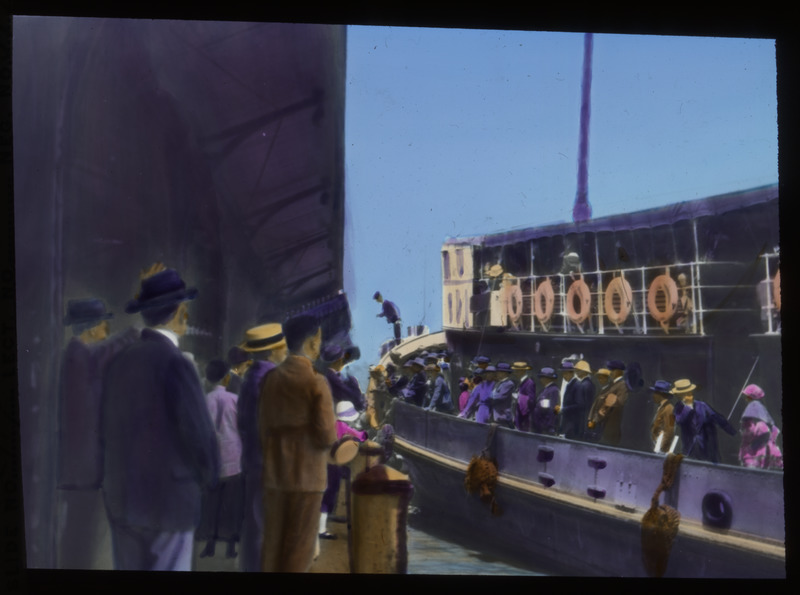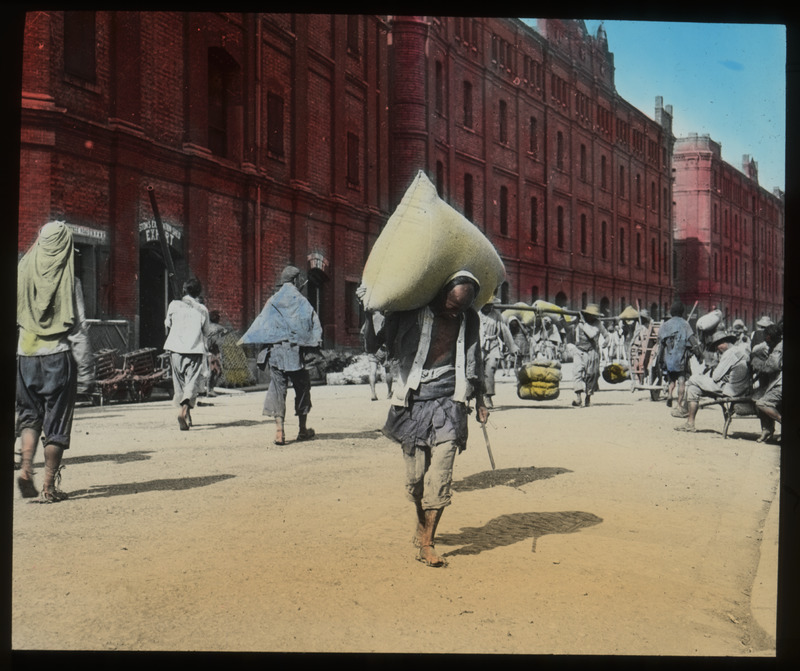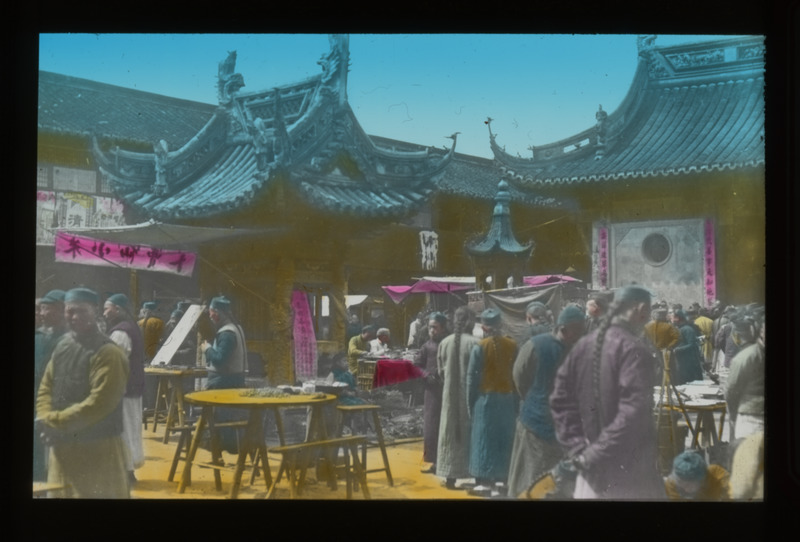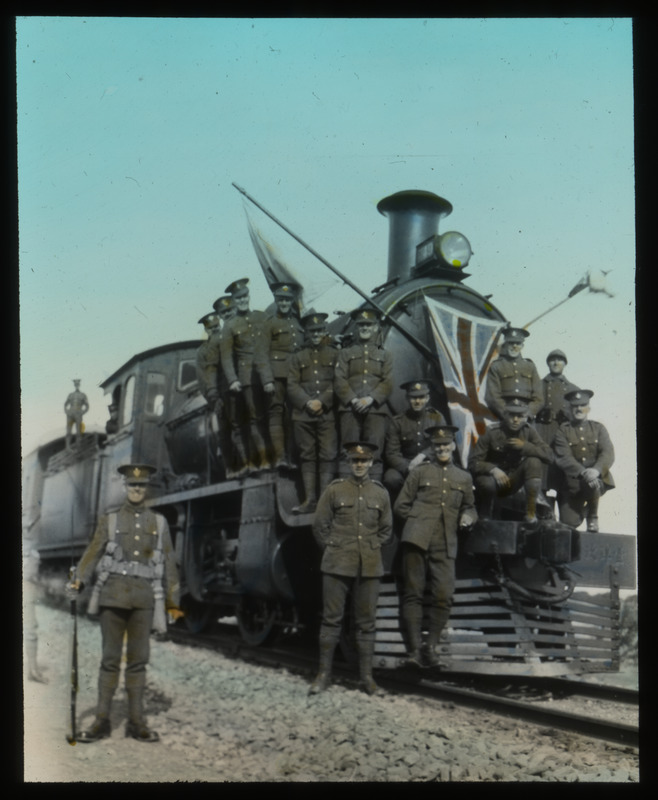John Calvin Ferguson 福開森 (1866-1945)
Collector of Chinese Art for American Museums
After seminary school training, in August 1887 John Calvin Ferguson joined the American Methodist Mission in Nanjing, where he stayed for ten years, intending to set up a western-style university. The endeavor began as a school named “Huiwen shuyuan” 匯文書院 or “Convergence of Culture” Academy in his living room. In 1891 the Academy moved into its own building and in 1893 it became Nanjing University by the State of Massachusetts, which consisted of a College of Liberal Arts, a School of Theology, a School of Medicine, and a School of Science. The first cohort of students graduated in 1897. Today the official founding date is given as 1902 and president Lü Jian’s website greeting only mentions that “…Nanjing University and its predecessors have taken responsibility for the country and the nation during its development of over 100 years.”[1]
This restraint in referring to the erstwhile foreign influence is hardly surprising: the presence of the Methodist Mission in Nanjing (as well as in Zhenjiang, Shanghai, and elsewhere) had been one result of the treaties China had been forced to sign during the Convention of Beijing in 1860 after losing the Second Opium War (1856-1860). The Treaty of Tianjin (signed by China in Beijing) had institutionalized “freedom of religion” in China among other demands. It forced open access to cities in China’s interior for foreign merchants and missions, thus making China’s resources accessible to foreign powers, whose merchants craved trade opportunities for profit and whose missionaries craved opportunities for indoctrination. Nanjing University’s first buildings were built on land purchased with money secured through Ferguson’s fundraising efforts. Ferguson began to study the Chinese language in Zhenjiang, where he lived with his wife Mary for a year before moving to Nanjing, and where he also became attracted to and familiar with Chinese culture and art. Many years later, in 1928, he decided to donate his personal art collection of more than a thousand objects to Nanjing University.[2]
Ferguson’s affinity for Chinese culture and for developing educational concepts and institutions for Chinese citizens proved more substantial than his zeal to convert them to Christianity, facts that did not go unnoticed by influential Chinese colleagues and friends. In 1897 he received an offer to work for the Qing dynasty (1644-1911) government, which was attempting to reform the education system. Ferguson was charged to create a Western-style school in Shanghai. In collaboration with his patron, the Chinese reformer Sheng Xuanhai 盛宣懷 (1844-1916), he created Nanyang College (南洋公學), a school with a mixed curriculum of Chinese and Western academic disciplines, following the now famous motto of China’s modernizers “Chinese learning for a substantive foundation, Western learning for functional application” (中學為題,西學為用). (The Western ‘functional application’ ultimately included a soccer team).[3]
Ferguson moved his family of six (wife Mary, daughters Helen, Florence, and Mary, and sons Luther and Charles) to 16 Love Lane in the British concession of Shanghai, where more three sons (Robert, Duncan, and Peter) were born.[4] In addition to buying land and founding the school (today part of the campus of Jiaotong University), Ferguson published a small Chinese-language newspaper, the Xinwenbao 新聞報, which became Shanghai’s largest circulating daily newspaper and provided substantial financial resources for his family.[5]
Life in Shanghai
In the wake of the Opium Wars, Shanghai had developed into the national site of ‘modernization’ in areas as diverse as education, international banking, transportation, and industrial production. It was also the leading commercial center where prominent Western companies and banks with investment interests established trade representations and consular offices. Soon after moving to Shanghai, Ferguson had to leave behind his educational endeavor, since a foreign college president would have challenged nationalist sentiments. His Chinese patron appointed him as secretary of the Imperial Chinese Railway Administration.[6] At that time he may have met J.P. Morgan (1837-1913), an investor in the Hankow-Canton railway, who later bankrolled Chinese art acquisitions that Ferguson would make for the Metropolitan Museum of Art in New York.[7]
Shanghai was also the home of the North China Branch of the Royal Asiatic Society, which Ferguson served as president in 1911, while his professional occupation was to advise the governors-general of Jiangsu, Jiangxi, and Anhui provinces. (Later he also advised the leaders of Hubei and Hunan provinces.) During this time he became familiar with another governor-general, the Manchu official Duanfeng (1861-1911), who shared with Ferguson the appreciation for Chinese art. After the revolution of 1911 ended the dynastic rule of the Qing, Ferguson resigned his official posts when the Republic was founded in 1912.
In 1914 Ferguson returned to Massachusetts with his family to be closer to his older children who attended college at the time. But Ferguson had not only been familiar with the defunct political elite of dynastic times, but also with the political leaders of the young Chinese Republic, and was soon made advisor to the president of the Republic. In 1919 Ferguson, his wife Mary and their youngest daughter Mary moved back to Beijing into a house in 3 Xique Hutong 喜雀胡同in the southeastern section of the inner city of Beijing,[8] where he connected with art vendors and advised Western museums and collectors with burgeoning interests in Asian art.
Through his own experience, Ferguson knew that it was futile to study Chinese culture without an understanding of the ideas that guide art appreciation and connoisseurship. Thus, his study of Chinese art criticism from the Song (960-1279) to the Qing allowed him to evaluate art in accordance with the standards applied by Chinese collectors and antiquarians.[9] His reputation as an art collector brought him invitations to lecture about Chinese art, like the prestigious Scammon lectures at the Art Institute of Chicago,[10] later published as Outlines in Chinese Art, and to advise museums and collectors in their acquisitions. His political advice was appreciated by politicians of the Chinese Republic and so he continued his diplomatic work while simultaneously expanding his expertise in art and archaeology.
With time he came to play the role of a cultural mediator. On one side, he worked with Chinese intellectuals educated in western academic disciplines who were knowledgeable about the cultural role that public museums play in modern society and who perceived art as a tool to define national identity. On the other, he advised museums, such as the Metropolitan Museum and the Cleveland Museum of Art as well as individual collectors in the United States, among them Charles Lang Freer (1854-1919), whose original conceptualization of art had been shaped by European concepts.
A fruitful relationship
Most of Ferguson's patrons were quite ignorant about Chinese art and they relied on Ferguson’s judgment to acquire quality paintings, bronzes, jades, and other art objects to build their collections. Many of these collectors were guided by Orientalist concepts and saw the acquisition of Chinese art as a representation of their economic power. Yet some understood art as a means to educate the public and enhance their appreciation of another culture. Among the latter group was Gertrude Bass Warner (1863-1951).
Ferguson and Warner had first met through Gertrude’s husband Murray Warner (1869-1920), an engineer who helped to establish the engineering department of the American Trading Company and had participated in the defense of U.S. citizens who lived in Shanghai during the Boxer Rebellion in 1900. Murray Warner used Ferguson’s services to connect with investors in the railroad and shipbuilding building activities of China,[11] but he also shared Ferguson’s interest in Chinese art. Ferguson was well known both in China and the United States, but he no longer sold Chinese art in America. He continued to advise U.S. clients, and Gertrude Warner was among those with whom he remained in friendly contact until the end of his life.
After Warner’s husband had died in 1920, she traveled to Beijing every winter between 1924 and 1929, except in 1928. While in Beijing she stayed with the Fergusons and relied on John Ferguson’s advice to make acquisitions for the museum she planned to create. He also bought textiles and porcelain from dealers on Liulichang, the famous street of Beijing antique dealers on her behalf.[12] As a token of gratitude for his help, Warner helped to finance the 1928 publication of Ferguson’s book Chinese Painting by the University of Chicago Press.[13] In a letter dated July 8, 1927 Ferguson expresses his gratitude to Warner, whose financial support had prompted Chicago University Press to move forward with the publication project.
Over the years Ferguson sent an exquisite selection of objects in various materials from the imperial collection from Beijing to Eugene. Emperor Qianlong of the Qing dynasty had been an admirer of crystal and glass, especially colored glass, and so a number of excellent glass objects in fused glass, as well as red, blue, and yellow glass are today part of the JSMA collection. Ruth Clarke had glass objects shipped for the museum as well, which she had acquired for Warner following the advice of Ferguson. Warner liked the glass objects, especially the vases with a white body and red décor fused onto the white ground white so much, that her patriotic sentiments got the better of her. In a letter written on June 9, 1925, when Gertrude Bass Warner actively shaped her collection with the help of Ferguson to be able to represent all categories of art works that had been appreciated by China’s (Qing) emperors in her museum, she encouraged Ferguson to write a book about “old Chinese glass,” since she could not find the reference material she was looking for to educate herself about Chinese glass.[14] She then asked Ferguson, “Should you come across a vase in white, blue and red glass, the three colors, I would like a beautiful example of it very much, if you would be so kind as to get it for me.”[15] This was hardly a color combination the Qianlong emperor, though utterly fond of glass, its sheen and purity of color, would have fancied.
Harder times
The year 1925 was fateful for the Republic of China as well as the Fergusons and other foreigners living in China at the time. Sun Yatsen had died on March 12, which created a struggle for supremacy among the warlords and within the Guomindang. The party adopted Sun’s ideas, influenced by the Communist International and the Soviet supporters Mikhail Borodin (alias for Mikhail Markovich Gruzenberg, 1884-1951), Maling (alias for Hendricus Sneevliet, 1883-1942), and Soviet ambassador Lev Karakhan (1889-1937), a step that caused Ferguson to comment in a letter to Gertrude Bass Warner dated September 15, 1925: “It is idle to talk of a revival of Boxerism [referring to the Boxer uprising of 1900] or of China coming under the control of the Soviets. One must not confuse the alarming symptoms with the real disease. There is no doubt that China is sick, but her sickness is caused by misgovernment, and by some means or other the younger generation in China intend to have a better government than their fathers or grandfathers had. They may undertake their job in a very unintelligent and foolhardy way, but the principle underlying their actions is right; they want to make China a better country to live in.”[16]
Nineteen twenty-five became the year of strikes, especially in the textile industry, a large section of which belonged to Japanese textile companies that treated Chinese workers miserably. Not that Chinese factories treated their laborers any better, but in the Japanese factories, workers felt even more humiliated by the exploitation through foreigners. Chinese workers went on strike, which became an instrument of labor negotiations in a country where the concept of a strike had been unknown until a short time previously. When Gu Zhenghong, a textile worker, was killed during a strike, enraged protesters on Shanghai’s Nanjing Road marched against a police station. The police started to shoot at the protesters and killed twelve of them. What made matters dangerous for foreigners now was the fact that the command to shoot had been given by an inspector named Everson, a British national in service with the Chinese police.[17]
Ferguson remained undeterred in his service to China and continued his work as a government adviser as well as an adviser to collectors of Chinese art. In addition to the glass objects desired by Gertrude Bass Warner, he also sent jade vases, several metalwork objects, including an incense burner, furniture screens, ceramic vessels and dishes, textiles (including tapestries, cushion covers, and carpets), as well as paintings, the category of art object he himself probably enjoyed the most.
In 1928 he saw an opportunity to get a set of twelve exquisite paintings for Warner’s museum. He knew the paintings well since they came from the collection of a friend for whom he had bought them two decades earlier. The friend had fallen on hard times and needed to sell the paintings, for which Ferguson paid Mex. $ 3,000.[18] Ferguson purchased the paintings without prior notification to Warner, because he had learned that the Republican government planned to place an embargo the export of Chinese cultural goods at the port of Tianjin after January 1, 1929: “It is quite possible that similar steps will be taken in Shanghai on January 1st and in order that your Museum should at least have the chance of having a few good Chinese paintings I have purchased the lot, and have paid for them. You may think that I have taken great liberty in doing so and I quite agree with you, but I am sure also that you will approve of what I have done. It was a rare chance, and I did not want to miss it.”[19] In a follow up letter Ferguson sent to Gertrude Bass Warner dated December 21, 1928, we learn that Warner had consented to the purchase of the twelve paintings[20] he had selected and commented on as follows: “The paintings that I sent you were all good though they are not signed by great masters. So often these seals and signatures have little meaning and it is always the painting itself which counts. I’m not sure whether you had already seen the pictures when you cabled me, but if not I am sure that you will be more delighted than ever when you see them.”[21]
During the Sino-Japanese war the Fergusons continued to live in Beijing. Mary Ferguson had been of fragile health for quite some time and in 1938 she passed away. Her husband and daughter brought her ashes to their family burial site in Newton, Massachusetts, and then returned to Beijing. Due to John Ferguson’s age and health condition they were not sent to the internment camp in Weixian that Gertrude Bass Warner’s friend Ruth Clarke and her husband Eric had to move to in 1943 during the Japanese occupation. But in September of the same year the Fergusons were repatriated when the governments of Japan and the United States began to exchange their nationals. The Fergusons and other American and British nationals were shipped to Goa where they boarded a Swedish ship, the Gripsholm, after the exchange against Japanese citizens. On December 2, 1943 the Gripsholm brought John Ferguson and his daughter Mary to New York via Port Elizabeth, South Africa, and Rio de Janeiro, Brazil.
The friendship between Ferguson and Warner had continued over all the years after the museum at the University of Oregon had officially opened its doors. In July 1944, Ferguson wrote to Warner from the Devon Hotel in New York, where he and Mary lived. After his return to the United States John Ferguson’s health declined rapidly. He passed away on August 3, 1945, just days before the end of World War II.
References
[1] https://www.nju.edu.cn/EN/president/main.htm accessed 05/22/2019. A different section of the university website lists Huiwen shuyuan as one of the predecessors: https://www.nju.edu.cn/EN/glance/list.htm accessed 5/22/2019.
[2] Thomas Lawton, A Time of Transition: Two Collectors of Chinese Art. Kansas: Spencer Museum of Art. University of Kansas, 1991. The Franklin D. Murphy Lectures XII, 95.
[3] The best assessment of the complex role John C. Ferguson played in Chinese cultural circles and in shaping the acquisition of Chinese art in institutional and private collections of the United States is by Lara Jaishree Netting: A Perpetual Fire. John C. Ferguson and His Quest for Chinese Art and Culture. Hong Kong: Hong Kong University Press 2013. Netting (2013), 23.
[4] Netting (2013), 22 & 45.
[5] Netting (2013), 24.
[6] Netting (2013), ibid.
[7] Netting (2013), 25.
[8] The pronunciation for 雀is que, but has been transcribed as chiao or ch’iao [= qiao] by Ferguson. The address is located close to the current railway station. However, the hutongs have been demolished. (Netting 2013, 247, fn. 19.)
[9] Netting (2013), 29-35.
[10] Thomas Lawton, A Time of Transition: two collectors of Chinese art. Kansas: Spencer Museum of Art. University of Kansas, 1991. The Franklin D. Murphy Lectures XII.
[11] As advisor to President of the Republic Xu Shichang (1855-1939), Ferguson acted as the middleman to secure a contract for a battle ship to be built by Fairfield Shipbuilding as we learn from a letter to Murray Warner dated September 3, 1915. (Gertrude Bass Warner papers, Box 5, Folder 2, pp. 27-34.)
[12] Netting (2013), 118.
[13] See also Netting (2013), 248, fn. 43, which refers to Gertrude Bass Warner’s correspondence with John Calvin Ferguson on 9/15/1925, 1/12/1925, 19/9/1925, 6/26/1944, 9/8/1944.
[14] Ferguson never wrote such a book, since collecting glass was not a focus of his interest. Only in the late 20th century did scholars take up the topic and she would have found publications of the kind she was looking for.
[16] Gertrude Bass Warner papers, Box 5, Folder 2, pp. 80-3. Some of China’s “sickness” of course had its origins in the imperialism of the foreign empires the Opium Wars, that forced China to enormous reparation payments placing a heavy burden on her budget.
[17] For an excellent explanation of the events and their historical effects see Dieter Kuhn, Die Republik China von 1912 bis 1937. Entwurf für eine politische Ereignisgeschichte. Heidelberg: edition forum 2004. Würzburger Sinologische Schriften.
[18] The Mexican silver dollar remained a legal currency in China until the 1930s.
[20] Registered under MWCH 32 in the JSMA.







